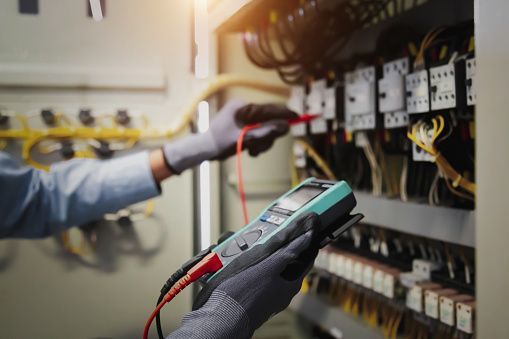What Is a Short Circuit?
Your Complete Guide to Short Circuits
Any and every electrical problem that occurs in a home setting is always blamed on a short circuit. But what does that mean exactly, and how do you find it, and how can you fix it in your home?
What is a short circuit?
Short circuits are shortcut paths. Electrical circuits are set up to follow specific paths through which electricity should flow. Short-circuiting occurs when a shorter, alternative path presents itself, thereby having the electricity flow in a route that was not previously established. The excessive flow of current in the new path causes electrical appliances to stop working.
Electrical currents tend to take the path of least resistance. For example, suppose you insert a metal object in a socket. In that case, you are providing the electrical currents with a shorter, alternative route to travel, and it will almost always take it.
When this happens, the socket will stop functioning as expected since the currents did not finish the expected route. By following the new path, the electrical currents will seek to be discharged through a person or an item that presents the danger that might come with electrical circuits.
Short circuits occur in two types. These are:
Short circuits
Short circuits occur when a hot wire comes into contact with a neutral wire. This causes resistance to lessen dramatically, and an influx of current flows through the newly established path. This has more chances of causing accidents. Electricians find this to be the most common short circuit.
Ground fault short circuits
Ground faults occur when a hot wire comes into contact with a grounded part of the electrical system, for example, a grounded metal box or bare copper wire. When this occurs, the electrical currents choose the path of least resistance and flow through the newly established path. These types of short circuits have minimal chances of causing accidents.
How to find a short circuit
The task of finding or detecting short circuits is something that you should have a professional carry out. However, some of the things that might alert you to the occurrence of short-circuiting are:
Faulty wire insulation
Insulation allows wires to stay in place without touching. Poorly insulated wires can be as a result of old wires whose insulation has deteriorated, punctured by screws or nails, or have been chewed on by rodents. When the wires are open, it provides an avenue where the hot wires can quickly contact the neutral wires, causing short-circuiting.
Loose wire connections
If wires become loosely attached, this can create a scenario where the hot wires can contact the loose wires. This might act as a hazard, so it is always essential to have a professional electrician look at it.
Faulty appliance wiring
When you plug in a device into the socket and blows, a wiring problem in the appliance causes the short circuits. This happens because once the appliance is connected to the socket, it becomes part of the established electric current path.
Therefore, any defect brings about short-circuiting either in the appliance itself, the plugs, or the power cords. When this happens, it is always important to contact a professional to fix your appliances and prevent other short circuits.
In essence, you can be able to find the area at which short-circuiting occurred by:
- Checking for faulty wire insulations
- Checking for loose wire connections
- Checking for appliances that might have faulty wiring, especially if they blow when connected to power sources.
These usually act as useful pointers on finding short circuits, but it is always essential to consult a professional electrician.
How to fix the problem
Once you suspect that you might be experiencing short-circuiting in your home, it is essential to try and find the short circuit’s exact location before even attempting to fix it. To do this, we make use of a circuit breaker.
Circuit breakers are designed to cut off electrical current flow if the voltage exceeds a given level. In short, it cuts off the current flow if any fault is detected. That said, a circuit breaker can trip if there is a power overload.
However, if you notice that your circuit breaker keeps on constantly tripping after every reset, that might indicate that there is something wrong on that circuit path.
During installation, multiple circuit breakers are assigned for specific rooms of the home sections in your service panel. To help you find out where the short-circuiting is happening:
- Identify the circuit breaker that has tripped to the off position. This will alert you that short-circuiting might have occurred in that given part of the house. Leave the circuit breaker in the OFF position.
- Check the appliances in those rooms. If you discover that their power plugs have been damaged, remove them from the sockets. Once you do this, switch on the circuit breaker. If it does not go off again, it means the short-circuiting cause was the affected appliance. However, if it does go off again, the issue did not originate from the appliances.
- Check the lights and appliance switches in these rooms. With the circuit breaker still on, switch on and off each light and appliance switch. If any of these cause the circuit breaker to trip to the off position, that might cause the short circuits.
Once you have located the area that the short-circuiting is occurring, it is advisable to get a professional electrician to advise you on fixing short circuits. This ensures that you do not engage in anything that might harm you or your family members. Electrical faults are the main causes of fires in homes and industries, and they are all due to short circuits. Therefore, caution should be taken to prevent damages from resulting.
Mister Sparky Electrician is Tulsa's On-Time Electrician in Broken Arrow, Jenks, Bixby, Sapulpa, and Claremore. Our team of licensed electricians services the Tulsa metro area. In addition to emergency electrical repairs, our residential electrician services include electrical outlet/switch repair, ceiling fan installation, lighting installation, residential wiring repair, landscape lighting installation, and home electrical inspections. Call us today at (918) 205-1309 to schedule an appointment!
You might also like

Don’t stay left in the dark about what to do.
Call us anytime day or night and experience the Mister Sparky Tulsa
difference. We’ll get you up and running safely, with expert, same-day service at prices you’ll appreciate.
Tulsa’s On-Time Electrician
9906 E 43rd Street, Ste G
Tulsa, OK 74146
Call Us Anytime, Day or Night! (918) 205-1309
License Number: #OK00215400
Emergency Services
Emergency Electrical Repairs
Electrical Inspections
Electric Panel Repair
Surge Protection
Electrical Installation & Repair
Outlet & Switch Repair
Ceiling Fan Installation
Electrical Wiring Repair
Smoke Detector Installation
Indoor Lighting Installation
Landscape and Outdoor Lighting Installation
Electric Vehicle Chargers
Electrical Panel Upgrades
Home Backup Generators
Electric Panel Upgrades
Mister Sparky® Tulsa | Terms & Conditions | Privacy | Accessibility | Site Map




